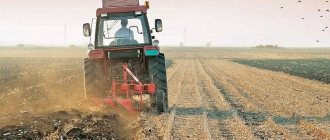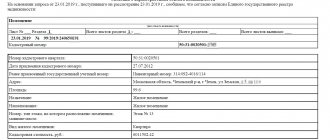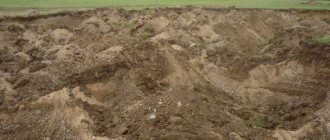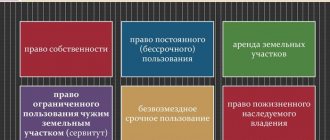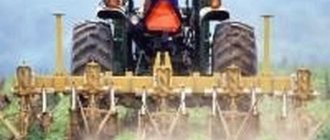Forest fund lands - general information
LEGAL REGIME OF FOREST LANDS
To forest lands
relate:
• forest lands,
including lands covered with forest vegetation and not covered with it, but intended for its restoration (clearings, burnt areas, open areas, dead stands, areas occupied by nurseries, clearings, wastelands, etc.);
• non-forest lands,
intended for forestry (clearings, roads, swamps and other lands).
On January 1, 2007, the Forest Code of the Russian Federation, adopted on December 4, 2006, came into force. The new Code established a fundamentally different approach to the regulation of forest relations.
Forests located on forest fund lands are divided according to their intended purpose into protective forests, operational forests and reserve forests. Features of the use, protection, protection, reproduction of protective forests, operational forests and reserve forests are established by the Forest Code of the Russian Federation.
Forest management is carried out on forest lands, as well as on lands of defense and security, settlements, and specially protected natural areas where forests are located.
Forest fund lands in accordance with Art. 3 of the Federal Law “On the entry into force of the Forest Code of the Russian Federation” are federal property.
The disposal of forest areas, state ownership of which is not demarcated, is carried out by executive authorities of the constituent entities of the Russian Federation, local governments in accordance with land legislation (Article 10 of the Federal Law “On the implementation of the Forest Code of the Russian Federation”).
The Forestry Code establishes minimum rents depending on the type of use of forest plots (with or without withdrawal of forest resources), on the basis of which the amount of rent is determined (Article 73).
A lease agreement for a forest plot located in state or municipal ownership is concluded based on the results of an auction for the sale of the right to conclude such an agreement, held in accordance with Chapter. 8 of this Code.
The provision of forest plots in state or municipal ownership for permanent (indefinite) use, gratuitous fixed-term use to legal entities and gratuitous fixed-term use to citizens is carried out in the manner established by the Land Code of the Russian Federation, unless otherwise provided by the Forest Code of the Russian Federation. The Forestry Code of the Russian Federation defines three cases when a forest plot can be provided for use not on a lease basis, but on other rights: on the right of permanent (indefinite) use (for example, to state-owned enterprises), gratuitous fixed-term use (for example, during the construction of a hydraulic structure based on state or municipal contract entirely at the expense of budgetary funds).
Section VII. FOREST LAND, WATER LAND
FUND AND LAND RESERVE
The powers of the Councils of People's Deputies, provided for in Art. 94 of the Land Code of the RSFSR, are carried out by the relevant local administrations.
Concept, composition and legal regime of forest lands.
Previous49Next
The lands of the forest fund include forest lands (lands covered with forest vegetation and not covered with it, but intended for its restoration - clearings, burnt areas, open spaces, clearings, etc.) and non-forest lands intended for forestry (clearings, roads, swamps) and etc.). The procedure for the use and protection of forest lands is regulated by the Land Code of the Russian Federation and forest legislation.
The legal regime of forest fund lands is determined by the legal regime of the forests located on them. In accordance with the Land Code of the Russian Federation, forest legislation is applied to forest protection relations. The Forest Code of the Russian Federation establishes the legal basis for the rational use, protection, protection and reproduction of forests, increasing their environmental and resource potential. Forests are subject to protection from fires, pollution and other negative impacts, as well as protection from harmful organisms. The use, protection, protection, and reproduction of forests are carried out based on the concept of the forest as an ecological system or natural resource.
Forests are located on forest fund lands and lands of other categories. The use, protection, protection, and reproduction of forests are carried out in accordance with the intended purpose of the lands on which these forests are located. The boundaries of forest fund lands and the boundaries of lands of other categories on which forests are located are determined in accordance with land legislation, forestry legislation and legislation on urban planning activities.
Forest legislation regulates forest relations, i.e., it applies to forests included and not included in the forest fund, and to forest lands not covered with forest vegetation. Forestry and land legislation regulates relations in the sphere of use and protection of forest lands. A forest plot is a land plot, the boundaries of which are determined in accordance with the provisions of forest legislation on forest management.
Forest areas within the forest fund lands are federal property. Forms of ownership of forest plots as part of lands of other categories are determined in accordance with land legislation. Citizens have the right to freely and freely stay in forests and, for their own needs, harvest and collect wild fruits, berries, nuts, mushrooms, other edible forest resources (edible forest resources), as well as non-timber forest resources.
Forest plots are provided for permanent (indefinite) use, lease, and free fixed-term use. Forest plots in state or municipal ownership are provided to legal entities for lease, and free-of-charge use for a fixed-term period is provided to citizens.
The provision of forest plots in state or municipal ownership for permanent (indefinite) use, gratuitous fixed-term use to legal entities and gratuitous fixed-term use to citizens is carried out in the manner prescribed by the Land Code of the Russian Federation, unless otherwise provided by the Forest Code of the Russian Federation.
Forestry legislation applies to land relations when these relations are not regulated by land legislation.
Previous49Next
Date added: 2016-07-18; views: 2032; ORDER A WORK WRITING
Similar articles:
Article 101 of the Land Code. Forest fund lands
(Decree of the President of the Russian Federation of December 24, 1993 N 2287).
Article 94. Forest lands
Lands of the forest fund are considered to be lands covered with forests, as well as those not covered with forests, but provided for the needs of forestry and the forest industry.
The procedure for using forest fund lands is regulated by the legislation of the RSFSR and the republics that are part of the RSFSR.
Agricultural and other lands not used for the needs of forestry and the forest industry may be provided to forestry and industrial enterprises for temporary use for agricultural purposes in accordance with Article 14 of this Code.
In places where small peoples and ethnic groups live, the relevant Councils of People's Deputies provide for use and lease to collective farms, state farms, state industrial enterprises, as well as ownership, possession or lease to citizens of forest land for reindeer herding and hunting.
Article 95. Lands of the water fund
Lands of the water fund include lands occupied by reservoirs, glaciers, swamps, with the exception of tundra and forest-tundra zones, hydraulic engineering and other water management structures, as well as lands allocated for right of way (along the banks) of reservoirs, main inter-farm canals and collectors.
The lands of the water fund are used for the construction and operation of structures that ensure the satisfaction of drinking, domestic, health and other needs of the population, as well as water management, agricultural, environmental, industrial, fishery, energy, transport and other state and public needs.
The procedure for using water fund lands is determined by the legislation of the RSFSR and the republics that are part of the RSFSR.
Article 96. Reserve lands
Reserve lands are all lands that are not provided for ownership, possession, use and lease. These also include lands, the right of ownership, possession and use of which has been terminated in accordance with Articles 39 - 44 of this Code.
Reserve lands are under the jurisdiction of rural, town, city, and district Councils of People's Deputies in accordance with Article 23 of this Code.
Features of the legal regime of forest lands
⇐ PreviousPage 12 of 12Article 101. Lands of the forest fund 1. Lands of the forest fund include forest lands (lands covered with forest vegetation and not covered with it, but intended for its restoration - clearings, burnt areas, open spaces, clearings and others) and non-forest lands intended for forestry lands (clearings, roads, swamps and others). 2. The boundaries of forest fund lands are determined by delimiting forest fund lands from lands of other categories in accordance with forest management materials. Data on the boundaries of forest fund lands are entered into the state land cadastre. 3. Confiscation of lands occupied by forests of the first group for state or municipal needs is allowed only in exceptional cases provided for in subparagraphs 1 and 2 of paragraph 1 of Article 49 of this Code. 4. The transfer of forest fund lands to lands of other categories is carried out in accordance with subparagraph 1 of paragraph 1 of Article 8 of this Code, taking into account the environmental protection requirements established by federal laws. 5. Non-forest lands of the forest fund, temporarily not used for forestry, on the basis of a decision of the executive body of state power provided for in Article 29 of this Code, may be leased for a period of up to five years for agricultural production. The conditions for the use of such lands and restrictions on their use are established by land lease agreements. 6. The procedure for the use and protection of forest lands is regulated by this Code and forest legislation. In accordance with the Forest Code of the Russian Federation, all forests, with the exception of forests located on defense lands and lands of populated areas (settlements), as well as forest lands not covered with forest vegetation (forest lands and non-forest lands), form a forest fund that is located in federal ownership.
State administration in the field of use, protection, protection of the forest fund and forest reproduction is carried out by the territorial body of the Federal Forestry Management Authority. The scope of the Committee's activities is determined by Federal legislation, internal regulatory and other documents of the Federal Forestry Service of Russia.
In accordance with the Constitution of the Russian Federation, forest legislation of the Russian Federation is under the joint jurisdiction of the Russian Federation and the constituent entities of the Russian Federation.
State control over the use, condition, reproduction, protection and protection of forests is also assigned to state environmental protection agencies. But, unfortunately, at the moment these committees are not able, for a number of objective reasons, to fulfill the functions of state control assigned to them by Russian legislation in this area.
The functions of forest fund owners in forest management are determined by the Forestry Code of Russia. One of these functions is carrying out intermediate felling (under certain conditions).
Thus, forestry enterprises combine the functions
owner of the forest fund (1); forestry management (2); forest management, forest reproduction, forest care (3); state control (4) over the condition, use, reproduction, protection and protection of forests.
And this combination of incompatible functions is the main drawback of the forestry system that has developed in Russia. Russia controls itself - fulfilling the duties of a forest owner, management activities, economic activities, forest management, etc., which cannot but lead and does lead to negative consequences for the state of forest ecosystems and for the country's economy. Especially in modern conditions of extreme insufficiency of budgetary financing of forestry.
Concept and composition of water fund lands Types of water bodies. Ownership of water bodies.
Article 102. Lands of the water fund 1. Lands of the water fund include lands occupied by water bodies, lands of water protection zones of water bodies, as well as lands allocated to establish right of way and protection zones for water intakes, hydraulic structures and other water management structures and facilities. 2. Lands of the water fund can be used for the construction and operation of structures that ensure the satisfaction of the population’s needs for drinking water, household, health and other needs of the population, as well as for water management, agricultural, environmental, industrial, fishery, energy, transport and other state or municipal needs, subject to compliance with established requirements. 3. To protect sources of drinking and domestic water supply, protection zones are established, within which a special legal regime for land use is introduced. 4. The procedure for the use and protection of water fund lands is determined by this Code and water legislation.
Legal regime of water fund lands:
Lands of the water fund include lands occupied by reservoirs, glaciers, swamps, with the exception of tundra and forest-tundra zones, hydraulic engineering and other water management structures, as well as lands allocated for right of way) of reservoirs. The legal regime of these lands is determined by the legislation of the Russian Federation and its constituent republics, in particular the Water Code of the Russian Federation, the resolution of the Council of Ministers of the RSFSR “On approval of the regulations on water protection zones (strips) of rivers, lakes and reservoirs in the RSFSR. All water bodies in the Russian Federation are part of a single state water fund; they can be in private, state, municipal and other forms of ownership.
Individuals and legal entities acquire the right to use surface water bodies on the grounds and in the manner established by Chapter 3 of this Code.
Features of the legal regime of water fund lands
Article 102. Lands of the water fund 1. Lands of the water fund include lands occupied by water bodies, lands of water protection zones of water bodies, as well as lands allocated to establish right of way and protection zones for water intakes, hydraulic structures and other water management structures and facilities. 2. Lands of the water fund can be used for the construction and operation of structures that ensure the satisfaction of the population’s needs for drinking water, household, health and other needs of the population, as well as for water management, agricultural, environmental, industrial, fishery, energy, transport and other state or municipal needs, subject to compliance with established requirements. 3. To protect sources of drinking and domestic water supply, protection zones are established, within which a special legal regime for land use is introduced. 4. The procedure for the use and protection of water fund lands is determined by this Code and water legislation.
Legal regime of water fund lands:
Lands of the water fund include lands occupied by reservoirs, glaciers, swamps, with the exception of tundra and forest-tundra zones, hydraulic engineering and other water management structures, as well as lands allocated for right of way) of reservoirs. The legal regime of these lands is determined by the legislation of the Russian Federation and its constituent republics, in particular the Water Code of the Russian Federation, the resolution of the Council of Ministers of the RSFSR “On approval of the regulations on water protection zones (strips) of rivers, lakes and reservoirs in the RSFSR. All water bodies in the Russian Federation are part of the unified state water fund; they can be in private, state, municipal and other forms of ownership
⇐ Previous12
Concept and general characteristics of forest lands
The forest fund occupies more than a third of the territory of the Russian Federation. The legal regime of the forest fund and the lands occupied by it is regulated in detail by the LC of the Russian Federation, adopted by the State Duma on January 22, 1997. It regulates forest relations taking into account the idea of a forest as a set of forest vegetation, land, wildlife and other components of the natural environment, as a natural site of significant environmental, economic and social significance.
The law names the forest fund of the Russian Federation, forest fund areas, forests not included in the forest fund, trees and shrubs and forest fund lands as objects of forest relations.
Ownership, use and disposal of forest resources and forests not included in the forest fund is carried out taking into account the global ecological significance of forests, their reproduction, duration of cultivation and other natural properties of the forest.
The forest fund and forests located on defense lands are federal property. In accordance with federal law, it is possible to transfer part of the forest fund into the ownership of constituent entities of the Federation.
Forms of ownership of forests located on the lands of urban settlements are established by federal law (Art.
Forest fund lands
19 LC RF).
Let's consider the composition of forest relations objects.
Forest fund. All forests, with the exception of forests located on defense lands and lands of populated areas (settlements), as well as forest fund lands, form a forest fund: The boundaries of the forest fund are determined by delimiting forest fund lands from other categories in accordance with forest management materials. Data on the boundaries of forest fund lands are entered into the state land cadastre (clauses 1, 2 of Article 101 of the Land Code of the Russian Federation).
Forest fund lands. This fund includes forest lands and non-forest lands. Forest lands include lands covered with forest vegetation and not covered with it, but intended for its restoration (clearings, burnt areas, dead stands, open spaces, wastelands, clearings, areas occupied by nurseries, open forest crops, and others). Non-forest lands are understood as lands intended for the needs of forestry (lands occupied by clearings, roads, agricultural lands, and other lands), as well as other lands located within the boundaries of the forest fund (lands occupied by swamps, rocky placers, and other inconvenient for land use).
Forest fund areas. These are areas of forest, as well as areas of forest land not covered with vegetation, and areas of non-forest land. The boundaries of forest fund areas must be marked in situ using forestry signs and (or) indicated in planning and cartographic materials (forest maps).
Forests not included in the forest fund. These are forests located on defense lands and urban forests.
Tree and shrub vegetation not included in the forest fund is recognized as tree and shrub vegetation located on:
- agricultural lands, including lands provided for gardening and personal farming;
- transport lands (on the right-of-way of railways and highways);
- lands of populated areas (settlements), including those provided for summer cottages, housing and other construction (with the exception of urban forests);
- lands of the water fund (on canal rights-of-way); lands of other categories.
Legal regime of forest lands
It should be borne in mind that the inclusion of land plots in the forest. fund, as well as their withdrawal from it, are implemented in the manner established by the land and forestry legislation of the Russian Federation.
It is advisable to include lands that are covered or not covered with forest-type vegetation as forest lands. The second case suggests a purpose that is restoration. These are clearings, dead stands, burnt areas, open spaces, clearings, wastelands, areas occupied by open forest crops, nurseries, and so on.
In accordance with Art. 9 of the RF LC, it is advisable to include forest areas as the territory of the forest fund, as well as areas of territories that are not covered with forest vegetation. This includes non-forest land plots. It is important to keep in mind that the boundaries of the forest fund must be designated in kind by means of special forestry signs. They must be indicated in plan-cartographic materials (so-called forest maps).
Let's consider a diagram of the lands of the forest fund of the Russian Federation:
It shows that on the territory of the country these lands are the predominant category. That is why it is fundamentally important to pay as much attention as possible to their preservation and development.
It is necessary to take into account that the provisions of the civil legislation in force in Russia regarding the objects of civil rights are applicable to the forest fund territories, as well as to the rights of use. In addition, you should pay attention to the provisions of the country’s legislation on plots of land, unless otherwise specified by this code. These rules are also used in relation to forest areas that are not included in the forest fund.
The requirements of the current article apply to forest areas that are not included in the forest fund, unless otherwise provided by laws at the federal level. Those lands that, although there is forest vegetation, are endowed with a different purpose are not included in the fund. It is worth noting that Article 11 of the RF LC completely excludes from the fund vegetation of the tree and shrub type, which is located on lands of agricultural significance, including those provided for personal farming and gardening. And also on:
- Transport lands (in particular, on rights-of-way of roads and railways).
- Settlements, population. points, including those provided for housing, dacha and other construction (with the exception of urban forests).
- Areas of the water fund of the Russian Federation (these are canal right of way).
- Land territories of other categories.
Peculiarities of forest land management
State forest management is based on the principles:
- sustainable development (balanced economic development and improvement of the environment);
- rational, continuous, non-exhaustive use of the forest fund in the interests of the Russian Federation and its constituent entities;
- incompatibility of the implementation of public administration functions in the field of use, protection, protection of the forest fund and forest reproduction with the implementation of final felling and processing of the resulting wood (Article 50 of the RF LC).
State administration in the field of use, protection, protection of the forest fund and forest reproduction is carried out by the Government of the Russian Federation directly or through federal executive bodies authorized by it.
The executive authorities of the constituent entities of the Federation carry out these functions in the field of forest resources directly or through the territorial bodies of the federal forestry management body, if this is provided for by an agreement between the federal executive authorities and the executive authorities of the constituent entities of the Federation on the transfer of part of the said powers. The regulations on the federal forestry management body are approved by the Government of the Russian Federation. This body exercises the powers assigned to it directly or through its territorial bodies. The functions of state forest management are currently assigned to the Ministry of Natural Resources of the Russian Federation. It operates on the basis of the Regulations on the Ministry of Natural Resources of the Russian Federation, which was approved by Decree of the Government of the Russian Federation of September 25, 2000 No. 72. This Ministry organizes and ensures rational, multi-purpose, continuous and sustainable forest management; ensures the implementation of rights of ownership, use and disposal of forest resources; maintains state records of the forest fund; in accordance with the established procedure, distributes forests into groups and forest protection categories of the first group; carries out the transfer of forests from one forest group or from the forest protection category of the first group, respectively, to another group or category. It considers, in accordance with the established procedure, applications for the transfer of forest lands to non-forest lands for use for purposes not related to forestry and use of the forest fund, as well as for the seizure of forest fund lands.
Confiscation of lands occupied by forests of the first group for state and municipal needs is allowed only in exceptional cases provided for by the Land Code of the Russian Federation (Article 49). The transfer of forest fund lands to lands of other categories is carried out by the Government of the Russian Federation, executive bodies of state power of the constituent entities of the Federation and local government bodies in accordance with their powers provided for by the Land Code of the Russian Federation (Article 8).
The use of forest fund areas can be carried out both with the withdrawal of forest resources and without withdrawal. They are provided for one or more types of forest use to one or more forest users.
Activities involving the use of forest resources are subject to licensing.
The LF of the Russian Federation establishes the rights and obligations of forest users (Articles 82, 83).
Payments in the form of forest taxes or rent are collected for the use of the forest fund.
Forest taxes are collected for all types of forest use. Forest tax rates are established by government bodies of the constituent entities of the Federation in agreement with the territorial forestry management body or determined based on the results of forest auctions.
The amount of rent, the procedure, conditions and terms for its payment are determined by the lease agreement for the forest fund site.
Forest users are citizens and legal entities who are granted the rights to use forest areas and the rights to use forest areas not included in the forest fund.
The said right of forest use arises on the basis of a lease agreement for a forest area, an agreement for the gratuitous use of a forest area, a concession agreement for a forest area, as well as a logging license, order or forest ticket.
In the event of the death of a citizen, his forest use right is transferred to another person in accordance with a will or law. When a legal entity is reorganized, its forest use rights are transferred to a legal entity that is the legal successor of the reorganized legal entity. According to the concession agreement, such a transfer of forest use rights is prohibited (Article 24 of the RF LC).
§2. Management of forest lands
When determining the composition of non-forest lands, it is advisable to be guided by forest rather than land legislation of the Russian Federation.
According to state land records, as of January 1, 2007, the total area of forest land was 1,096,844.7 million hectares, i.e. about 70% of the Russian Federation's landmass. Among the forest fund lands, areas occupied by forests account for 73%, swamps - 9%, other water bodies - 2%, agricultural lands, built-up areas, roads, deer pastures and other objects - 16%.
The legal literature indicates that the commonality of the legal regime of all forest lands is determined by their intended purpose. At the same time, the needs of forestry are mentioned as the purpose of the forest fund lands. In paragraph 1 of Article 101 of the Land Code, the purpose of these lands is the restoration of forest vegetation and forestry. The intended purpose of forest fund lands is established taking into account their purpose. The structure of forest fund lands is such that its components can be used for different purposes or not used at all.
Taking into account the indicated features of forest lands, clause 2 of Article 101 of the Land Code requires that they be delimited from lands of other categories. The forest fund and forests not included in it do not include tree and shrub vegetation located on:
— agricultural lands, including lands provided for gardening and personal farming;
— transport lands (on rights-of-way of railways and highways);
— lands of populated areas (settlements), including those provided for country houses, housing and other construction (with the exception of urban forests);
— lands of the water fund (on canal rights-of-way);
- lands of other categories.
Forest lands are intended to serve as the spatial-territorial basis of forestry.
Depending on the economic, environmental and social significance, location and functions performed, forest legislation distinguishes forests of the first, second and third groups.
The first group includes forests that primarily perform water conservation, protective, sanitary, hygienic and health-improving functions, as well as forests in specially protected natural areas.
Forests of the first group are divided into the following categories of protection: restricted forest strips along the banks of rivers, lakes, reservoirs and other water bodies; restricted forest strips protecting spawning grounds for valuable commercial fish; anti-erosion forests; protective forest strips along railways, highways of federal, republican and regional significance; state protective forest belts; band burs; forests in desert, semi-desert, steppe, forest-steppe and low-forest mountain areas, which are important for the protection of the natural environment; forests of green zones of settlements and economic facilities; forests of the first and second zones of sanitary protection zones of water supply sources; forests of the first, second and third zones of the sanitary (mountain sanitary) protection districts of resorts; especially valuable forest areas; forests of scientific or historical significance; natural monuments; walnut fishing zones; forest fruit plantations; tundra forests; forests of state natural reserves; forests of national parks; forests of natural parks; protected forest areas.
CONCEPT AND COMPOSITION OF FOREST LAND
Forest fund lands -
one of the significant area categories of land. These lands serve as the main means of production in forestry. Relations related to the use and protection of these lands are regulated by both land and forestry legislation.
The concepts of forest and lands on which forests are located are combined in the Forest Code of the Russian Federation. In accordance with Art. 7 of the Forest Code of the Russian Federation, the forest fund includes all forests, with the exception of those located on the lands of settlements and defense, as well as lands not covered by forest vegetation, but belonging to the forest fund.
The main part of the forest fund is formed by forests. The forest fund and forest fund lands do not include: trees and groups of trees, as well as other tree and shrub vegetation on agricultural lands; protective plantings on the right-of-way of railways, highways, and canals; trees and groups of trees, as well as greenery in cities and other populated areas, growing on lands not occupied by urban forests; trees and groups of trees on personal, country and garden plots.
All forests form a single state forest fund. This fund consists of:
1) forests for state purposes, i.e. forests managed by state forestry authorities, urban forests, assigned forests and forest reserves;
2) collective farm forests, i.e. forests located on lands provided to collective farms for use.
Forests are the property of the state and are provided only for use; Actions that directly or covertly violate the right of state ownership of forests are prohibited.
In accordance with the economic importance of forests, their location and functions, forests are divided into groups.
To the first group
include forests that perform water protection, protective, sanitary and hygienic, health and other functions related to maintaining the natural balance, maintaining environmental well-being, forest reserves, national and natural parks, protected forest areas, forests of scientific or historical significance, natural monuments, forest parks, forest fruit plantations.
Co. second group
include forests in areas with high population density and a developed network of transport routes, which have protective and limited operational significance, as well as forests with insufficient forest raw materials, which require a more strict forest management regime to preserve the protective functions of which, the continuity and inexhaustibility of their use; all collective farm forests that were not included in the first group.
To the third group
These include forests in multi-forest areas that are primarily of operational importance and are intended to continuously meet the needs of the national economy for wood without compromising the protective properties of these forests. Forests of this group are divided into developed and reserve.
Legal regime of forest lands of the Republic of Belarus
Content
Introduction
1. Composition of the lands of the Republic of Belarus. Distribution of lands of the Republic of Belarus by category
2. General characteristics of management in the field of land protection and use
3. Functions of state land management and their characteristics
Conclusion
List of used literature
Application
Introduction
The land has a value that distinguishes it from any other material object, it is the habitat of all previous and future human generations, it is limited in space and is the basis for the placement of productive forces.
Due to its natural properties, the earth acts as a universal basis for the placement of objects necessary to ensure the life of society (cities, industrial, historical and cultural objects, etc.). Thanks to its fertile soil cover, land is the main means of production in agriculture and forestry. These properties of the land are reflected in the legal norms of certain categories of land in accordance with their intended purpose.
The value of land as a resource lies in the fact that land can act as a means of production (crop areas, gardens, etc.), as an object of industry legislation, as an object of real estate transactions, as the basis for the life and activities of peoples living in the corresponding territory, as a certain territory and in other qualities.
Rational use of land is considered one of the most important principles of land law. As a principle of law, the rational use of land is expressed in the requirement for their effective exploitation by landowners, land users, and land owners. The content of this principle is determined both by the general requirements for the use and protection of lands in general, and by the specifics of the legal regime of a particular category of land. When using agricultural lands, this principle requires increasing their fertility, increasing crop yields, organizing effective economic exploitation of these lands, and at the same time requires proper protection of agricultural lands. The use of non-agricultural lands, taking into account the principle of rationality, involves ensuring their strictly targeted use with maximum effect for landowners, land users, owners and taking into account the requirements for the protection of both land resources and the environment as a whole.
The above determines the relevance of this course work, the purpose of which is to study the features of the distribution of the land fund of the Republic of Belarus by types and categories, determine the functions and importance of state management of the land fund.
The object of the study is the legal relations between business entities and the state that arise in the process of using the first agricultural lands that arise in modern conditions of economic activity.
The subject of the study is the legal framework regulating the legal regime of the lands of the Republic of Belarus, defining the powers of public authorities in the field of protection and use of land resources.
The analysis of problems associated with the effective use of land resources in the Republic of Belarus of agrarian reform will occur through the interpretation of the norms of substantive and procedural branches of law (research method).
It seems necessary to solve the following problems:
1) determine the composition of the lands of the Republic of Belarus;
2) conduct an analysis of legal norms to determine categories of land;
3) study the process of distribution of lands of the Republic of Belarus by categories and types at the current stage of development;
4) give a general description of management in the field of protection and use of land;
5) determine the functions of state land management and characterize them;
The work uses the texts of regulations, comments to them, as well as educational and monographic literature concerning the issues of land reform in the Republic of Belarus, statistical data on the dynamics of the land fund for the period 2006-2008. Theoretical studies of the most prominent specialists in the field of land law were used: Balashenko S.A., Bakinovskaya O.A., Demichev D.M., Mikulich A.V., Leshilovsky P.V. and others. The empirical basis of the study is built on normative material and practice of local government and self-government bodies.
The methodological basis of the study is the dialectical method. During the study, general and specific scientific, as well as special methods of cognition were used. Common methods were analysis and synthesis, induction and deduction, observation and comparison. The special methods used in the work include the formal legal method, methods of legal modeling, and various ways of interpreting the law.
The practical significance of the work lies in the fact that it examines the issue of the efficiency of using the land fund in the Republic of Belarus at the present stage, determining the effectiveness of state management of the land fund, based on studying the practice of local government and self-government bodies in this area.
1. Composition of the lands of the Republic of Belarus. Distribution of lands of the Republic of Belarus by category
One of the foundations of sustainable development of society is the organization of rational use and protection of land resources, due to the formation of an optimal structure of the land fund, environmentally sound and balanced use of land, and minimizing the negative impact on lands of economic production. The main areas of activity in the field of protection and rational use of lands and soils are determined by the National Action Plan for the rational use of natural resources and environmental protection of the Republic of Belarus for 2006-2010.
In accordance with Art. 6 of the Code of the Republic of Belarus on Land, the lands of the Republic of Belarus are divided into the following categories:
— agricultural land;
— lands of settlements, gardening partnerships, dacha cooperatives;
— lands of industry, transport, communications, energy, defense and other purposes;
— lands of environmental, health, recreational, historical and cultural purposes;
— forest lands;
— lands of the water fund;
- reserve lands [5, art. 6].
At the same time, lands and land plots are distributed into the specified categories depending on their main purpose and the legal regime for their use and protection determined in accordance with the legislation [15, p. 76].
Transfer of lands, land plots from one category to another is carried out in cases of change in the main purpose of these lands, land plots during the withdrawal and provision of land plots, termination of the right of permanent or temporary use, lifelong inheritable possession, private ownership and lease of land plots, submission by land users applications for the transfer of lands and land plots from one category to another.
Agricultural lands include land plots that include agricultural and other lands provided for farming.
Here we can note the following factors due to which such a large aspect is given to agricultural lands: limitation (constancy of quantity); immobility; non-recreation; indestructibility; practically inexhaustible productive force [16, p.44].
Since ancient times, agricultural lands have provided humanity with everything it needs. And it is no coincidence that the legislator places them in first place among the seven categories of land in the country’s land fund allocated in the legislation.
Their main purpose is the production of agricultural products. In other words, here the land acts not only as the basis for production activities, but also, above all, as the main means of production. Therefore, when characterizing these lands, such an important property as fertility is highlighted. In the absence of fertility, agricultural production is impossible [15, p.76].
Agricultural lands include agricultural lands, lands occupied by on-farm roads, communications, trees and shrubs intended to ensure protection of lands from the effects of negative (harmful) natural, anthropogenic and man-made phenomena, closed reservoirs, as well as buildings, structures, structures , used for production, storage and primary processing of agricultural products [17, p. 112].
Due to the peculiarities of the legal regime of agricultural lands and their value to the people, the legislator provides guarantees establishing the priority of land use.
Land suitable for agricultural needs is provided primarily for agricultural purposes. The possibility of changing the intended purpose of these lands and their withdrawal from agricultural use is strictly limited.
When providing a land plot for agricultural purposes, the legislator does not provide for the priority of providing the land plot depending on what agricultural forms of farming the applicant intends to use this land for [16, p.46].
Agricultural lands can be used for agricultural production, the creation of protective plantings, research, educational and other purposes related to agricultural production:
- citizens, including those leading peasant (farm) households, personal subsidiary plots, gardening, livestock raising, and gardening;
-economic partnerships and societies, production cooperatives, state enterprises, and other commercial organizations;
— non-profit organizations, including consumer cooperatives, religious organizations;
-experimental and production, educational, educational and experimental and educational and production units of research organizations, agricultural educational institutions and general educational institutions.
The seizure of productive lands that are particularly valuable for a given region, including experimental fields (sites) of scientific research institutions and educational institutions, as well as lands of natural reserves, historical and cultural sites and other specially protected areas, is not allowed.
If an unlawful seizure of agricultural land for non-agricultural production is established, not only the losses caused by such seizure, but also the loss of agricultural production are compensated.
In order to redistribute land for agricultural production, create and expand peasant (farm) holdings, personal subsidiary plots, gardening, livestock farming, gardening, haymaking, grazing, a land redistribution fund is created as part of agricultural lands.
The Land Redistribution Fund is formed for the purpose of land use planning, mainly from agricultural lands, which, in the event of a change in their intended purpose, nature of use or other change, can be used more effectively, and in the order of land management in each district by district executive committees at the proposal of the territorial bodies of the State Property Committee of the Republic Belarus [5, Art. 9].
Based on local conditions, the land redistribution fund is formed primarily for the purposes of:
— creation and development of agricultural organizations, including peasant (farm) farms;
— development of human settlements;
— creation and development of personal subsidiary plots of citizens, construction and (or) maintenance of single-family, semi-detached residential buildings, collective gardening, dacha construction;
17.1. Concept and general characteristics of the legal regime of forest lands
Reserve forests are forests that are not put into exploitation due to their distance from transport routes and other reasons.
When assigning forests to the corresponding groups, the boundaries of the lands occupied by the forests of each group are simultaneously determined. Forest lands are at the same time an independent object of legal regulation. The Land Code establishes the general procedure for the provision of forest fund lands, the main features of their legal regime, and the grounds for termination of the right to land use of these lands. At the same time, the use of forest lands is regulated by forest legislation.
In the Republic of Belarus, forest lands constitute one of the largest categories of land.
Forest fund lands perform important functions: they serve as the main means of production in forestry, maintain the ecological balance, and serve as a reserve for the expansion of economic activities not directly related to the use of forests (agriculture, construction, transport industries).
The internal structure of forest fund lands is enshrined in legislation. These lands are divided into lands covered with forests and lands not covered with forests, but intended for forestry needs. The term "forest area" is broader than the concept of forested land.
Non-forest areas include:
1) land - arable land, hayfields, pastures, other agricultural land;
2) lands under lakes, rivers, reservoirs;
3) forest roads, clearings, peat mining, land plots occupied by nurseries, quarries with fire breaks;
4) other land plots not suitable for growing forests - swamps, sands, ravines, steep slopes, etc. plots.
The biological unity of the forest and forest lands influences the interaction of the legal regimes of forests and lands. State management of the forest fund and forest fund lands are closely interconnected.
Date added: 2016-11-24; | Copyright infringement
Recommended content:
Related information:
Search on the site:
